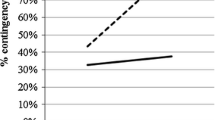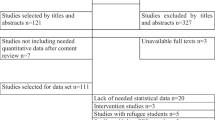Abstract
Student wellbeing can be considered a major output indicator of quality of education. A positive classroom climate can contribute to a higher sense of wellbeing. Interpersonal relationships between teachers and students are an important aspect of the classroom climate. This study investigated how student wellbeing was predicted by student characteristics, interpersonal teacher behaviour and achievement. 594 students from 55 classes in 13 technical and vocational secondary schools were involved in this study. The results indicated that those students who attended school because they were highly motivated learners reported a higher sense of wellbeing than those who attended out of a sense of duty. It also appeared that student perception of interpersonal teacher behaviour predicted student wellbeing. As a case in point, when students viewed their language teacher as tolerant yet exacting discipline, a positive relationship was found with student wellbeing. Students also felt better when their mathematics teachers were less authoritarian, but the cooperative component was still important.
Similar content being viewed by others
References
Arthaud-Day, M. L., Rode, J. C., Mooney, C. H., & Near, J. P. (2005). The subjective well-being construct: A test of its convergent, discriminant, and factorial validity. Social Indicators Research, 74, 445–476.
Brekelmans, M. (1989). Interpersoonlijk gedrag van docenten in de klas (Interpersonal behaviour of teachers in the classroom). Utrecht: Universiteit Utrecht.
Brusselmans-Dehairs, C., Van Den Broeck, A., Van Damme, J., & Valcke, M. (2003). Vlaanderen in TIMSS (Flanders in TIMSS). Brussel/Gent/Leuven: Ministerie van de Vlaamse Gemeenschap, departement Onderwijs/Universiteit Gent, Vakgroep Onderwijskunde/Katholieke Universiteit Leuven, Centrum voor Onderwijseffectiviteit en -evaluatie.
Creemers, B. P. M., & Reezigt, G. J. (1999). The role of school and classroom climate in elementary school learning environments. In: H. J. Freiberg (Ed.), School climate. Measuring, improving and sustaining healthy learning environments. London: Falmer Press.
Eccles, J. S., Lord, S., & Midgley, C. (1991). What are we doing to early adolescents? The impact of educational contexts on early adolescents. American Journal of Education, 99, 521–542.
Engels, N., Aelterman, A., Deconinck, E., Schepens, A., & Van Petegem, K. (2000). Het welbevinden in de schoolsituatie bij leerlingen secundair onderwijs (School wellbeing of students in secondary education). Gent: OBPWO project.
Engels, N., Aelterman, A., Schepens, A., & Van Petegem, K. (2004). Factors which influence the well-being of pupils in Flemish Secondary schools. Educational Studies, 30, 127–143.
Engels, N., Aelterman, A., Van Petegem, K., Schepens, A., & Deconinck, E. (2004). Graag naar school: een meetinstrument voor het welbevinden van leerlingen secundair onderwijs (Satisfaction at school: an instrument that measures student wellbeing in secondary education). Brussel: VUBpress.
Fraser, B. J. (1994). Research on classroom and school climate. In: D. L. Gabel (Ed.), Handbook of research on science teaching and learning: A project of the National science teachers association. New York: Macmillan.
Fraser, B. J., & Walberg, H. J. (1991). Educational environments: Evaluation, antecedents and consequences. UK: Pergamon Press.
Goldstein, H. (1997). Methods in school effectiveness research. School Effectiveness and School Improvement, 8, 369–395.
Knuver, A. W. M., & Brandsma, H. P. (1989). Pupil’s sense of well-being and classroom educational factors. In: B. P. M. Creemers, T. Peters, & D. Reynolds (Eds.), School effectiveness and school improvement. Lisse: Swets en Zeitlinger.
Knuver, A. W. M., & Brandsma, H. P. (1993). Cognitive and affective outcomes in school effectiveness research. School Effectiveness and School Improvement, 4, 189–203.
Konu, A. I., Litonen, T. P., & Autio, V. J. (2002). Evaluation of well-being in schools: A multilevel analysis of general subjective well-being. School Effectiveness and School Improvement, 13, 187–200.
Kristof, A. L. (1996). Person-organization fit: an integrative review of its conceptualizations, measurements, and implications. Personnel Psychology, 49, 1–49.
Levine, D. U., & Lezotte, L. W. (1990). Unusually effective schools: A review and analysis of research and practice. Madison, WI: National Centre for Effective Schools Research and Development.
Maslowski, R. (2003). Klimaat in de klas (Classroom climate). HSO, B4200.
Midgley, C., Feldlaufer, H., & Eccles, J. S. (1989). Student/teacher relations and attitudes toward mathematics before and after the transition to junior high school. Child Development, 60, 981–992.
Muijs, D., & Reynolds, D. (2005). Effective teaching. Evidence and practice (2nd ed.). London: Paul Chapman Publishing.
Opdenakker, M. C., & Van Damme, J. (2000). Effects of schools, teaching staff and classes on achievement and well-being in secondary education: Similarities and differences between school outcomes. School Effectiveness and School Improvement, 11, 165–196.
Samdal, O., Wold, B., & Bronis, M. (1999). Relationship between student’s perceptions of school environment, their satisfaction with school and perceived academic achievement: an international study. School Effectiveness and School Improvement, 10, 296–320.
Schaufeli, W., & Bakker, A. (2001). Werk en welbevinden. Naar een positieve benadering in de arbeids- en gezondheidspsychologie. (Work and wellbeing. Towards a positive approach in working and health psychology). Gedrag en organisatie, 14, 229–253.
Scheerens, J. (1990). School effectiveness research and the development of process indicators of school functioning. School Effectiveness and School Improvement, 1, 61–80.
Seligman, M. P., & Csikszentmihalyi, M. (2000). Positive psychology. American Psychologist, 55, 5–14.
Tagiuri, R. (1968). The concept of organizational climate. In R. Tagiuri, & G. Litwin (Eds.), Organizational climate. Explorations of a concept. (pp. 11–32). Cambridge, MA: Harvard University Press.
Van Damme, J., & Onghena, P. (2002). Educational effectiveness in secondary schools in Flanders [special issue]. School Effectiveness and School Improvement, 13, 381–451.
Van Damme, J., & Van Landeghem, G. (2002). Welbevinden en prestaties in de eerste en de tweede graad van het secundair onderwijs (Wellbeing and achievement in the first and second Grades of secondary education). Leuven: OBPWO project.
Van Den Broeck, A., Opdenakker, M. C., & Van Damme, J. (2005). The effects of students characteristics on mathematics achievement in Flemish TIMSS 1999 Data. Educational Research and Evaluation, 11, 107–121.
van der Veen, T. (1989). De school, een kwestie van overleven? Schoolbeleving van leraren en leerlingen.(School, a matter of survival? School perceptions of teachers and students). Leiden: Nijhoff.
Van Houtte, M. (2005). Climate or culture? A plea for conceptual clarity in school effectiveness research. School Effectiveness and School Improvement, 16, 71–89.
Vandenbroucke, F. (2004). Onderwijs en Vorming: Vandaag kampioen in wiskunde, morgen ook in gelijke kansen. (Education and Training: Today champion in mathematics, tomorrow also in equal chances). Brussel: Vlaamse Regering.
Verschelden, G. (2002). A social-pedagogical look at guidance in schools. Scientia Paedagogica Experimentalis, XXXIX, 197–216.
Wubbels, Th., Brekelmans, M., & Hooymayers, H. P. (1991). Interpersonal teacher behavior in the classroom. In: B. J. Fraser, & Walberg H. J. (Eds.), Educational environments: Evaluation, antecedents, and consequences. (pp. 141–160). London: Pergamon.
Wubbels, Th., Créton, H. A., Brekelmans, M., & Hooymayers, H. P. (1987). De perceptie van de leraar-leerling relatie (The perception of the teacher–student relationship). Tijdschrift voor Onderwijsresearch, 12, 3–16.
Author information
Authors and Affiliations
Corresponding author
Rights and permissions
About this article
Cite this article
Van Petegem, K., Aelterman, A., Van Keer, H. et al. The influence of student characteristics and interpersonal teacher behaviour in the classroom on student’s wellbeing. Soc Indic Res 85, 279–291 (2008). https://doi.org/10.1007/s11205-007-9093-7
Received:
Accepted:
Published:
Issue Date:
DOI: https://doi.org/10.1007/s11205-007-9093-7




